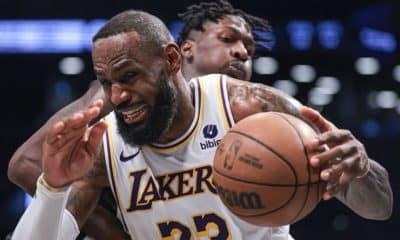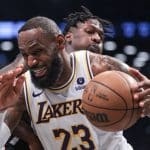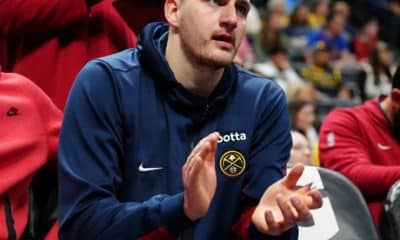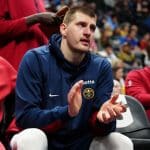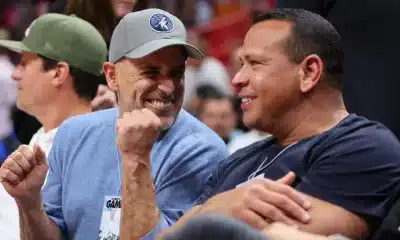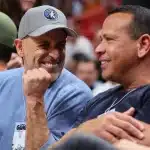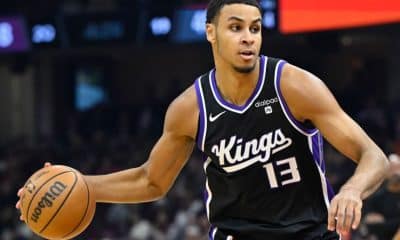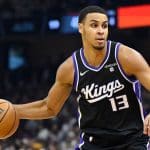NBA
2015-16 Utah Jazz Season Preview
Basketball Insiders previews the Utah Jazz’s 2015-16 season.
The Utah Jazz aren’t sneaking up on anyone this year. A strong close to the 2014-15 season, headlined by a historically great defense from the All-Star break forward, put Utah firmly on everyone’s radar out West, where they’re making a push to get back in the playoffs after a couple years out. The Jazz return a trio of Gordon Hayward, Derrick Favors and Rudy Gobert as their primary pieces, flanked on the wing by impressive rookie Rodney Hood and returning Alec Burks following shoulder surgery. The Jazz have significant depth at every position but point guard, and their 54-win pace post-All-Star-break last year came with the worst play at the one in the league, so there’s evidence they can survive another year until Dante Exum returns. The group stayed basically intact this summer and is in their second year under detail-oriented coach Quin Snyder. Expecting improvements elsewhere, particularly more comfort offensively, is reasonable. The Jazz are ready to make noise with a handpicked core, and no one is looking past them on the schedule.
Basketball Insiders previews the 2015-16 Utah Jazz season:
Five Thoughts
I love this Jazz team. Rudy Gobert is a monster, who will only continue to improve as he continues to gain experience and further his development. Derrick Favors has developed into a very talented big man who can make an impact on both ends of the floor. Gordon Hayward has made huge strides – as a player and as a leader. The injury to Dante Exum is extremely unfortunate, but I still believe Utah can sneak into the playoffs as the eighth seed in the Western Conference. They became a defensive juggernaut in the second half of last season and I think they can continue to cause a lot of problems on that end this year, especially since the team should be more comfortable under Quin Snyder in his second year as the team’s head coach. I’m really looking forward to watching this talented young core develop, and I think they’ll get some valuable playoff experience this season (and be very good in a few years).
2nd Place – Northwest Division
-Alex Kennedy
The Jazz showed promise as a young team on the rise last season. Gordon Hayward established himself as a near 20-point player, both Rudy Gobert and Derrick Favors averaged near double-doubles, and the Jazz drafted Dante Exum and Rodney Hood as key members of their future. They finished third in the Northwest Division after having one of the best winning percentages in the league after the All-Star Break. Now they look to carry the momentum into this season. They will have to do it without Exum, who suffered a torn ACL during international play for Australia. But while the defending champion Golden State Warriors and other contenders steal the spotlight in the Western Conference, expect the Jazz to continue quietly improving and flying under the radar with a core of young talent who could be the newest team to snag the eighth seed sooner rather than later.
3rd Place – Northwest Division
-Jessica Camerato
The Jazz just feel like a team ready to make a big leap. We’ve all been touting their fascinating young core for a couple of years now, but at some point the team has to stop being all about potential and start winning games. Losing Dante Exum for the year hurts, but Gordon Hayward looked every bit the max player he was paid to be last year and Rudy Gobert is transforming into one of the league’s more dominant defensive presences. Derrick Favors needs to emerge as a consistent star, and we’ll need to see quick development from guys like Rodney Hood and Trey Lyles, but this is a slick little team that could very well surprise some people. The Northwest is a division in rough shape, anyway, so Utah actually has a chance to do a little damage there this year.
2nd Place – Northwest Division
–Joel Brigham
There are a couple of things that will aid Utah’s ascent in the Northwest. The current rebuilding projects of Denver and Portland should serve to help elevate the Jazz in the final standings. The club also will benefit from the return of shooting guard Alec Burks and the continued development of interior force Rudy Gobert. The loss of guard Dante Exum stings, but make no mistake this is Gordon Hayward and Derrick Favors’ team at the end of the day. The Jazz, despite having some financial flexibility, didn’t make any big splashes over the summer, preferring to allow their young core to grow together. Ultimately, that may be the reason the team falls short of a playoff berth.
2nd Place – Northwest Division
-Lang Greene
Over their final 24 games of last season, the Jazz went 15-9 and we saw Rudy Gobert emerge as the most talked about big man in the league, at least for a few weeks. Clearly then, Jazz fans are among the most optimistic heading into this season. At least that was the case before Dante Exum’s ACL injury. A lot will immediately fall on the shoulders of Trey Burke, but this team needs Gordon Hayward and Derrick Favors to continue to earn their keep. As much as I like many of the pieces out there in Salt Lake City, it is difficult to imagine the Jazz getting into the playoffs. A team like the Mavericks, in my opinion, are still better and I have the Jazz clocking in outside of the playoff picture. Still, like the Orlando Magic, I think the light at the end of the tunnel is becoming brighter and that things are taking shape for Utah. Give them two more years.
2nd Place — Northwest Division
-Moke Hamilton
Top of the List
Top Offensive Player: Derrick Favors
Full disclosure: Gordon Hayward has a very good case here, and definitely is Utah’s most important offensive player (they just die without his creation), but Hayward is even more impossible to leave out of a couple areas. Favors is likely the most well-rounded Jazz player overall, and a varied offensive game is part of it.
Favors can do a little bit of everything after last season, when he finally expanded his shooting range to become a threat from the deeper midrange areas and particularly on rolling free-throw line jumpers in the two-man game. He’s long been a feared presence when the Jazz can get him the ball with momentum toward the hoop – no player in the NBA finished more plays via cuts to the hoop than Favors last season, per Synergy Sports. He’s among the game’s best finishers near the rim. He’s also a smart and underrated passer when teams crowd him on the catch, combining with Rudy Gobert to form a mostly unheralded frontcourt passing duo. Favors is a post option in a pinch as well, with a sneaky first step and effective push shots over both shoulders. Such a well-rounded game is welcome for the Jazz in certain units, and allows them to keep opponents off balance.
Top Defensive Player: Rudy Gobert
Not a whole lot of debate here. The Stifle Tower burst onto the scene last year, more than quadrupling his rookie minute total and serving as the driving force for the team’s defensive turnaround in just a couple short months. The big question this year is whether teams are able to more effectively scheme for Gobert’s presence. He’s no longer an out-of-nowhere guy anymore, and he’ll be at the top of scouting reports for opposing offenses. Teams started to get a bit more adventurous near the end of last season, downsizing to smaller lineups and forcing one of Gobert or Favors to guard a wing player – they might take these sorts of themes to a much more extreme point to attempt to get the big Frenchman out of his comfort zone.
There might not be a more powerful defensive force in the league, though. Gobert has far and away the widest shot blocking range in the NBA, altering teams’ entire game plan the moment he steps on the court. Easy looks at the rim simply cease to exist. And unlike many ground-bound rim protectors, Gobert has lateral speed – he can defend pick-and-roll attacks with a combination of mobility and ridiculous length, and even holds his own when switched onto the perimeter. If he stays healthy and continues to refine the edges of his game, he’ll be one of the league’s top defenders for a decade.
Top Playmaker: Gordon Hayward
Even when Dante Exum was healthy last season, this title unquestionably belonged to Hayward. He’s the team’s nucleus offensively, the only consistent option last season as a primary ball-handler until Rodney Hood made a late charge. He should get some further help with Alec Burks’ return from injury, but Burks is much more of a score-first option. Hayward led the Jazz in assist chances per game last season, per SportVU data, and is a very safe bet to do so again. Hood could lighten the load some for Gordon, but also didn’t showcase nearly as much as a passer and was generally only capable of generating his own looks. Unless incoming point guard Raul Neto exceeds expectations and can play 30 minutes a night (quite unlikely), Hayward is the guy.
Top Clutch Player: Gordon Hayward
More than any individual who is shooting the ball in clutch situations, the Jazz need Trey Burke to be the one who isn’t. Burke somehow took only six fewer shots than Hayward last season with the score within five and the clock under five minutes in regulation – Hayward scored 93 points on his 59 attempts, Burke a paltry 47 points on his 53 tries. If the Jazz’s coaching staff can get Burke to tone things down a bit, Hayward will lead the team in attempts and overall touches down the stretch by a large margin. He’s their most capable isolation player and best overall ball-handler, proving his chops on a big stage early last season with a game-winner as time expired to lift the Jazz over LeBron James and the Cavs. When Hayward doesn’t have the ball in his hands, look for Rodney Hood, Alec Burks or Derrick Favors to step up.
The Unheralded Player: Rodney Hood
Hood’s rookie year was marred early on by a series of injuries that kept him off the court and unable to develop any sort of rhythm with his teammates as they learned Quin Snyder’s new scheme. Once he saw the court and got into the swing of things, though, he was quietly one of Utah’s most impressive players. Hood shot 42 percent from three following the All-Star break on nearly four attempts per game, establishing himself as a knockdown guy both off the dribble and spotting up. He showcased a pick-and-roll game few rookies are capable of – incredible patience with his dribble and an ability to shield opponents on his back while he takes his time and finds the right option. His in-between floater already looks like a veteran’s, and he was much more impressive defensively than anyone had expected early on. Hood has work still to do as a distributor, but don’t bet against him making some strides early this season after all the jumps he made in just 50 total games last year. He’s already an absolute steal with the 23rd pick and could be one of Utah’s primary wing assets with another strong year.
Best New Addition: Alec Burks
Burks isn’t a newcomer by the most technical definition, but Jazz GM Dennis Lindsey has been consistent in half-ironically referring to Alec as the team’s “biggest offseason acquisition.” It fits if you think about it – the Jazz ushered in a new era of modern basketball when they hired Quin Snyder, and to a man the roster members have noted how it took several months for the group to collectively pick up Snyder’s complex scheme.
Unfortunately for Burks, shoulder surgery just 27 games into the season meant he wasn’t even on the floor when the team started to grasp things. He’ll have a steeper learning curve than most of his teammates, and a big part of his overall effectiveness will be determined by how quickly he learns on the fly. His slashing style is perfect for Snyder’s motion scheme, but Burks will need to tone down the me-first aspect of his game there to a degree. Defensively, he has major work to do away from the ball, where he’s been bad about spacing out and losing his man. But Burks was a breakout player in his last full season, a speedy penetrator who can get to the rack against anyone, and he’ll be yet another valuable wing asset for Utah if he picks things up.
– Ben Dowsett
Who We Like
Quin Snyder – Were it not for a few early-season injuries and Utah’s young core needing more time than anticipated to adjust to his approach (and had Enes Kanter perhaps been traded a bit earlier in the season), Snyder would have been a fringe candidate for Coach of the Year in his first campaign at the helm. What he did for a Jazz defense that ranked dead last in the NBA the year before his arrival was remarkable – it’s tempting to simply chalk it all up to Rudy Gobert, but the Jazz still had the league’s best defense by a mile after the All-Star break even when Rudy sat down (it was basically the same whether or not he played). The test for Snyder this year is on the other end of the floor. He’s repeated often that the offensive side of his scheme will take longer to come along than the defensive side; how quickly it does so – and just how effective it can be when things start to fully click – could determine Utah’s ceiling for the season.
Bryce Cotton/Raul Neto – Presumed initially to be fighting Burke for backup point guard minutes, Cotton and Neto have been thrust into more of a spotlight with Exum’s injury. At least one will have to play backup minutes, and maybe more if Burke can’t right his ship. Neto is an ACB transplant known for his passing and feisty defense, while Cotton played 15 games with the Jazz near the end of last season. Cotton is the best shooter among Utah’s healthy point guards but is also quite undersized (5’11 or so), while Neto is the right size but had a spotty jumper at a lower level. The Jazz could use a breakout performance from at least one.
Trevor Booker – Booker is Utah’s glue guy, and a team veteran at just 27 years old. He sets the emotional tone for the team even as a bench piece, working his butt off every day and quickly becoming a favorite among a fan base that identifies with these sorts of traits. He’s also a sneaky good NBA player – he shot a better percentage from three than Draymond Green last year, his first in the league with a license to fire away from deep. He’s a solid defender, a great rebounder for his undersized nature and a more versatile offensive piece than he’s given credit for. Booker is a legitimate third big who can offer some spacing and a change of pace from Gobert and Favors up front.
Tibor Pleiss – Possibly spending a number of his minutes with Booker will be Pleiss, Utah’s second foreign offseason addition. The 7’3 former Barcelona center backed up European superstar Ante Tomic last season, then was featured alongside Dirk Nowitzki in the frontcourt for the German national team with impressive results. The Jazz see a legitimate shooter in Pleiss despite a nearly nonexistent track record here in Europe – if they’re correct, he’ll be a major asset behind Gobert at center. In a perfect world, Pleiss and Booker combine for a spacing-overload lineup where both bigs on the floor are threats from deep. If he doesn’t pan out, his contract is cheap.
– Ben Dowsett
Strengths
Utah’s defense is the foundation of their identity. They’ve got length for days and the best rim protection duo in the league in the paint, and became better and better as last season wore on at funneling opposing ball-handlers to the places that allowed Gobert and Favors to operate optimally. Even lineups with some of their weaker defensive pieces were strangling teams after awhile. They’re also one of the top rebounding teams in the league on both ends.
The Jazz should have more depth to complement things as well. Pleiss and incoming 12th overall pick Trey Lyles should see minutes in the frontcourt, and Burks’ return will push the Jazz to five deep on the wing, all guys who have shown they’re capable rotation players or better at this level (Hayward, Burks, Hood, Joe Ingles and Elijah Millsap).
Finally, the team’s continuity under Snyder should play a role this season. His is a system that takes real time to master and a cohesive group to maintain, and keeping the primary pieces so similar to last season was an intentional move.
– Ben Dowsett
Weaknesses
Point guard play is the biggest concern. Brief late-season surges from Cotton and Burke aside, none of the three guys on Utah’s current roster have any track record as even average at the position in this league. Burke is in his third year as a lottery pick, and this may be his last chance. If he’s not up to it and the other two aren’t any better, it could be a long year at the one-spot while the team waits for Exum to return next season.
The Jazz will also likely be thin on spacing, especially if guys like Pleiss, Lyles and Booker aren’t threats there from the frontcourt. They’re similarly thin as far as primary creators, particularly if anything happens to Burks, Hood or especially Hayward.
– Ben Dowsett
The Burning Question
Can their defense remain elite over a full season, and can their offense catch up?
It’s really two questions, but the interplay between them could define the season for the Jazz. There could be a few simple tweaks available to goose Utah’s league-average offense from last season, but some of them – an emphasis on pushing in transition and the introduction of more small-ball, for instance – could potentially harm their airtight defensive culture.
Interested betting on the Utah team? – Don’t miss out on reading our guide about sports betting in Utah first!
Can Snyder toe the line here and find improvements on one end without a sacrifice on the other? The Jazz could still be the league’s best defense even if they fell off a bit from their post-All-Star-break pace last season. Put a borderline top-10 offense next to that, and you have the makings of a true contender.
It will be a struggle at times. Favors and Gobert are a devastating combo, but there are periods where the Jazz have to sweat for every bucket while they share the floor. A larger regression defensively isn’t entirely out of the question either, and this group has their work cut out for them if that happens.
It’s hard to find a team with a better defensive foundation, though. They’ll be better around the margins this year, and that alone will make them a fascinating team to watch.
– Ben Dowsett
Add Basketball Insiders to your Google News Feed!
-
Main Page 1 week ago
LeBron James joins Michael Jordan as only NBA players with multiple 40-point games after turning 39
-
Main Page 1 week ago
Nikola Jokic 1st NBA player since Oscar Robertson with 26+ points, 18+ rebounds, & 16+ assists in a game
-
NBA 1 week ago
Ex-MLB star Alex Rodriguez vows to keep trying to buy Timberwolves franchise despite rejection
-
Main Page 1 week ago
Kings are 14-5 this season when Keegan Murray scores 19+ points
